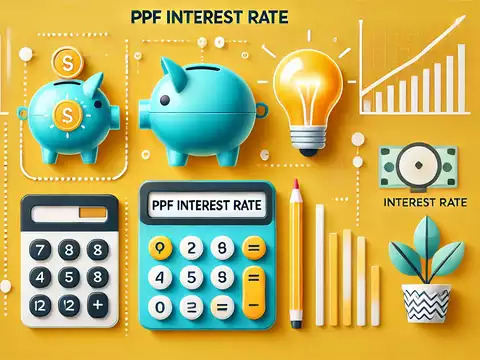Knowing the PPF Interest Rate for 2024: Important Shifts and How They Affect Investors

13 November 2024
One of the popular investment schemes in India is the PPF. The reasons for this popularity are attractive interest rates and tax benefits. As we approach 2024, it is very much a need to understand the subtleties associated with the interest rate that goes into the PPF, and using a PPF interest calculator would greatly benefit those who are planning long-term financial strategies.
Changes in PPF Interest Rate for 2024
The government has declared its PPF interest rate at 7.1% for the fiscal year 2024. The rate is unchanged and continues from the previous years’ fiscal rate. These macro-economic determinants also dictate the reason behind this retention of interest rate. Such determinants would include inflation, government borrowing, and overall economic growth in the country.
The PPF interest rate is set by the Ministry of Finance every quarter based on returns from government securities. Despite the fluctuations in market conditions, stability at a rate of 7.1% assures investors of a sound, secure channel for their saving.
Understanding PPF Interest Calculation
To comprehensively understand how the interest accumulates on your PPF investment, it is essential to use a PPF interest calculator. The interest is compounded annually, but it is calculated each month based on the lowest balance in the account from the 5th to the end of the month.
Here’s an illustration of how you can calculate the interest earned in a year:
1. Monthly Contribution: Let’s assume you contribute ₹5,000 at the beginning of each month.
2. Annual Contribution: This totals to an annual investment of ₹60,000 (₹5,000 x 12).
3. PPF Interest Accumulation: Using the PPF interest calculator with the current rate of 7.1%:
– Interest for Month 1: ₹5,000 x (7.1%/12) = ₹29.58
– Interest for Month 2: ₹5,000 x (7.1%/12) + (₹5,000 accumulated interest for previous month) = ₹59.17
This process continues for each month and sums up yearly to calculate your total interest earned.
For an annual investment of ₹60,000, the interest calculations month-on-month will yield:
Total Interest = ₹2,142.60 (approx—from monthly incremental interest)
This is a simplified calculation; a PPF interest calculator provides detailed, tailored results based on your specific investments and terms.
Impact on Investors
The consistency in the PPF interest rate reflects a stable investment environment. Here’s how it impacts different investors:
1. Long-term Scenarios: With a fixed interest rate of 7.1%, PPF remains an attractive option for long-term investers, spanning 15 years, with a possibility of extension.
2. Tax Benefits: The interest earned on PPF is tax-free, which adds to the effective yield of the investment. Additionally, the initial investments qualify for deduction under Section 80C of the Indian Income Tax Act, reducing the taxable income up to ₹1.5 lakhs annually.
3. Risk-Averse Investors: Given its sovereign guarantee, PPF is particularly appealing to risk-averse investors looking for stable and secure returns, compared to market-sensitive instruments.
4. Economic Conditions: The steadiness of the PPF rate amidst economic fluctuations illustrates the government’s approach to provide financial security via such instruments.
PPF Interest Calculator: Usage Benefits
Using a PPF interest calculator is instrumental in planning and maximizing your returns. Here’s why:
1. Accurate Projections: It provides precise calculations considering different deposit frequencies and sums, allowing investors to project their maturity amounts accurately.
2. Investment Planning: It aids in planning periodic investments, helping investors understand how different contributions affect their future returns.
3. Tax Planning: By knowing the exact interest and maturity amounts, investors can plan their finances better, optimizing tax benefits offered under the Indian tax laws.
Potential Downsides
While PPF offers remarkable benefits, investors should be aware of potential downsides, such as:
1. Lock-in Period: The 15-year lock-in period might be restrictive for those in need of high liquidity.
2. Limited Contributions: The maximum annual contribution is capped at ₹1.5 lakhs, which may not meet the requirements of high-net-worth individuals looking for larger tax-saving investments.
3. Interest Rate Changes: Though the interest rate for 2024 is stable, it’s subject to quarterly revisions, potentially altering the benefits for future calculations.
Conclusion
The PPF remains a stalwart of Indian savings schemes due to its stable interest rate and tax benefits. The unchanged interest rate of 7.1% for 2024 continues to offer a reliable means of investment for individuals planning their long-term finances.
Summary:
The PPF interest rate 2024 stands at 7.1%, reflecting stability amidst economic fluctuations. This rate continues from previous fiscal years, offering secure returns compounded annually, beneficial for long-term investors. Calculating interest using a PPF interest calculator aids in precise financial planning and maximizing returns, tailored to individual contributions.
The PPF’s tax benefits, risk-free nature, and structured investment framework appeal to diverse investors, particularly those with a long-term horizon. However, potential downsides include a 15-year lock-in period and contribution limits. Investors should review these aspects meticulously to align with their financial goals. The article underscores the necessity of careful consideration and professional consultation before investment.
The information provided is for educational purposes. Investors must evaluate all pros and cons of trading in the Indian financial market with professional advice.
Disclaimer:
This article serves informational purposes and should not be seen as financial advice. Investors are encouraged to evaluate all pros and cons of trading in the Indian financial market with their personal financial advisors.




